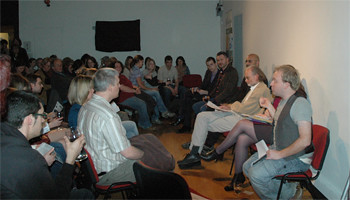The following is an essay written by Susan Bisson who spoke at a sciSCREEN following a screen of The Master.
As part of a panel asked to consider Paul
Thomas Anderson’s The Master my role
was to appraise the film from a filmic perspective or as a film text.
Reaction to a film often centres upon mimesis
or how closely a film mirrors the ‘real’ world.
A different sort of approach is to take the stance that the purpose of
art (in this instance film making) is to see the world with ‘fresh’ eyes or
even to ‘make strange’ the world. The
success of a film is often contingent upon the balance achieved between a
presentation of innovative material and a revisiting of well-trodden
ground. Too much innovation and a film
alienates; too little and all a film achieves is replication of what has gone
before. From audience feedback and from
reading reviews my impression is that for some Paul Thomas Anderson achieves
this balance in The Master but for
others the film is too ‘odd’ to be truly satisfying. Anderson’s other films,
which are characterized by their often melodramatic nature and complex
narratives have invited a similar range of response. Perhaps the most famous example of the
bizarre in Anderson’s work is the scene in Magnolia
where frogs rain from the sky!
Audiences derive pleasure from many different
aspects of a film. Guessing ahead,
taking sides with characters, being intrigued or puzzled and responding
aesthetically, sensually and intellectually to the film text are all important
factors. Intertextual references to the work of the same director or to other
films can also bring pleasure. At times
these pleasures can be contradictory; (it may be the characters that are
puzzling and consequently hard to fathom, for example). There are many pleasures to enjoy in The Master. Single shots such as the wake as the yacht
cleaves its way through the water and the atmospheric evocation of America at
the end of the Second World War immediately come to mind in terms of aesthetic
pleasure. Being intrigued is manifestly easy – perhaps too easy for some members
of the audience. Guessing ahead and taking sides with the characters are more
problematic as categories of audience pleasure. The nuanced nature of the
characters makes it difficult to assign roles such as hero and villain. I was
particularly intrigued by the portrayal of Lancaster Dodd’s wife, Peggy, whom I
read as an atypical blend of submission and assertion. Discussion after the screening of The Master revealed inconsistency in the
interpretation of the characters; this was felt to be a strength by some
audience members and a weakness by others. Similarly it is difficult to assign
the film a genre; a series of individual frames could be used to illustrate the
huge variety in landscape alone from the desert to the city to the ocean. There are also narrative challenges; I did
not feel confident, at any point, of how the film would end! The enigmatic
nature of The Master meant that it
stayed with me for a long time after the actual screening. In an interview with BBC’s Front Row Paul Thomas Anderson said that
the thing he most enjoyed about reading the reviews of The Master was that everyone
was different! This goes some way to confirming that it is a film which invites
discussion.









No comments:
Post a Comment